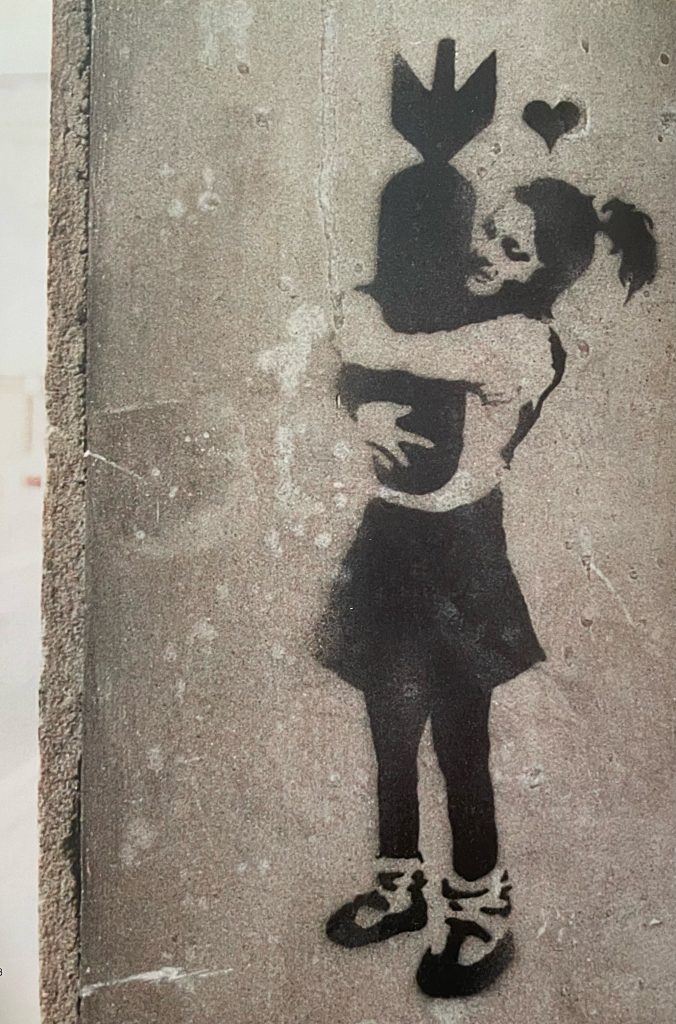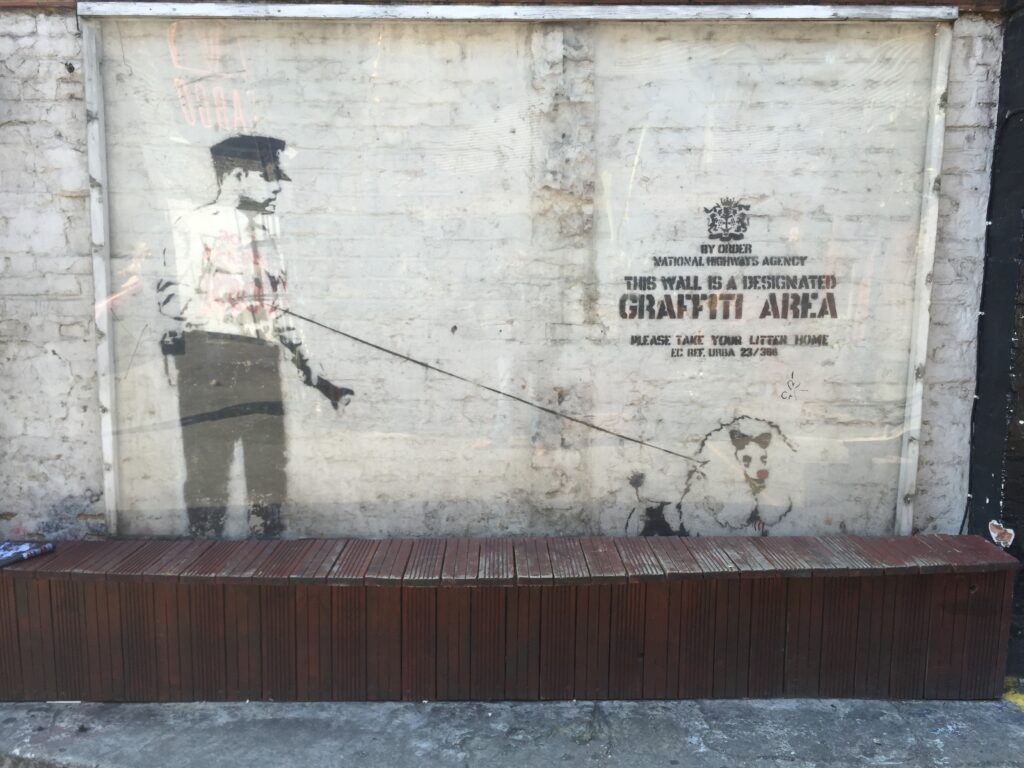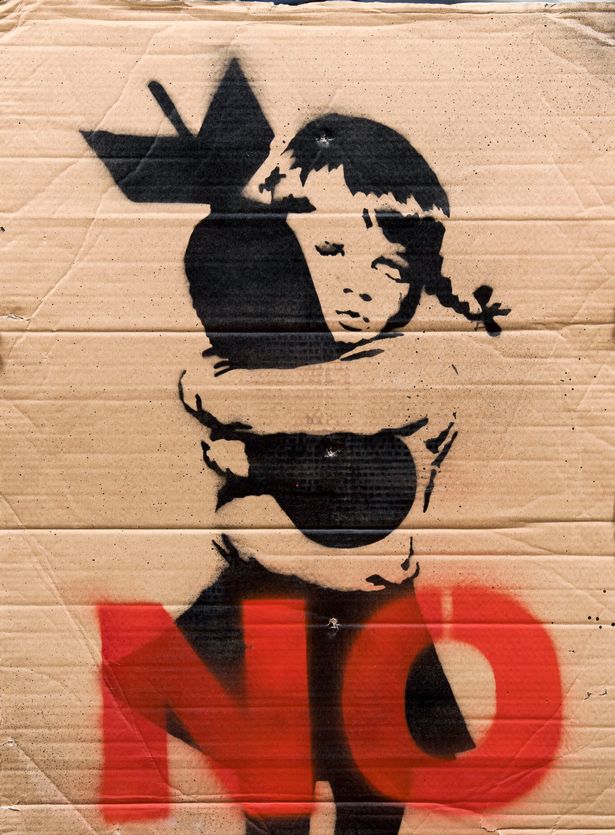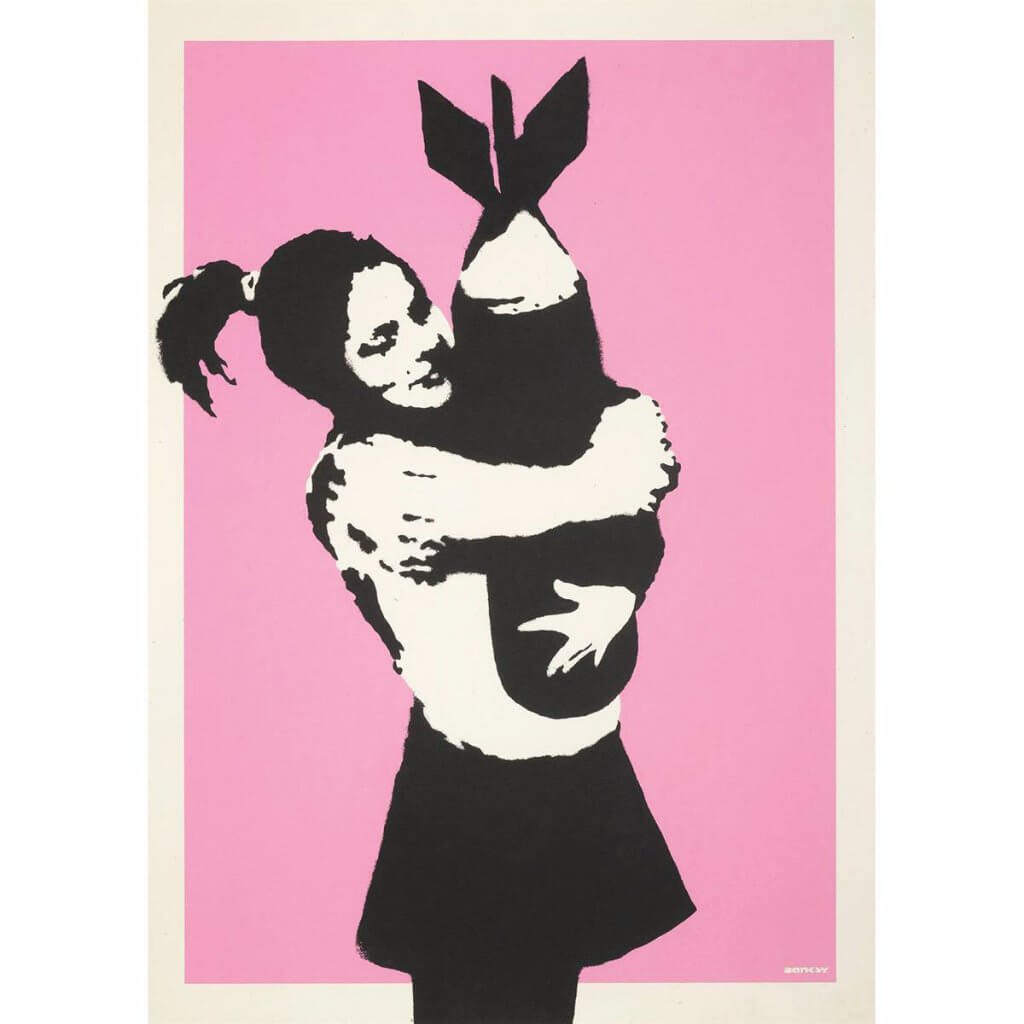Banksy’s ‘Bomb Love’ (a.k .a. Bomb Hugger or Bomb Girl) is an iconic piece of street art that remains one of Banksy’s most celebrated works that promotes peace and love.
‘Bomb Love’ first appeared in east London in 2001, in Bristol, and then later in Brighton and features a young girl hugging a bomb as if it were a cherished teddy bear. The stencil image is rendered in black and white, with the girl’s eyes closed and her chest and face pressed against the bomb’s surface. Her arms wrap around the bomb in a tender embrace, conveying a sense of love and affection towards the destructive object. Above the girl’s head is a heart, which serves as a powerful symbol of the artwork’s commentary on the power of love.

Banksy’s ‘Bomb Love”, Brighton 2003. Banksy Wall and Piece pg 24. Image copyright Banksy
Banging Your Head Against A Brick Wall
In 2001, Banksy released his first-ever book titled “Banging Your Head Against A Brick Wall,” which featured the iconic ‘Bomb Love’ artwork, along with other noteworthy pieces such as ‘HMV Dog’ and ‘Mona Lisa Bazooka.’ The book delves into the concept of “bombing” in graffiti and how it is often misunderstood as a violent or aggressive act. In the book, Banksy highlights the peaceful and creative nature of graffiti, emphasising that “bombing” refers to a concentrated effort to create art in a specific area, which can be seen as a peaceful act of creative expression rather than vandalism or destruction. The inclusion of ‘Bomb Love’ in the book provided a significant platform for the artwork’s message of love and peace to be spread to a wider audience.
“People are fond of using military terms to describe what they do.
We call it bombing when we go out painting, when of course it’s more
like entertaining the troops in a neutral zone, during peacetime in a
country without an army.”Banksy “Banging Your Head Against A Brick Wall”
Again in 2001, Bomb Love was also prominently featured at Banksy’s “Banging Your Head Against A Brick Wall” solo exhibition in ‘The Yard’ at the Cargo Night Club, London. The exhibition showcased many of the artist’s notable works painted on the courtyard walls, including the ‘Bomb Love’ piece, ‘HMV Dog, ‘Mona Lisa Bazooka’ and ‘Graffiti Area’. As part of the exhibition, there was a police car parked in the yard that Banksy had graffitied.

Street Art Shoreditch, London 2013/2014. Image © Graffitistreet.com
Existencilism
The year 2002 marked Banksy’s first-ever exhibition in Los Angeles, held at the 33 1/3 Gallery. The exhibition, titled ‘Existencilism’, was a clever take on the word “Existentialism” and featured some of Banksy’s most iconic artworks on canvas. Among the works showcased were ‘Bomb Love’, ‘Love Is In The Air’, ‘Barcode’, ‘Bird and Grenade’, ‘Queen Victoria’ and ‘Laugh Now’. The exhibition cemented Banksy’s reputation as an influential and boundary-pushing artist and helped to bring his works to America.
“I like to think I have the guts to stand up anonymously in a Western democracy and call for things no one else believes in – like peace and justice and freedom.”
Banksy (Wall and Piece Book pg 24-25)
Art and Protest
‘Bomb Love’, has been an inspiration for various forms of art and protest. In 2003, the image of the young girl embracing a bomb was used as a motif for a series of placards during a protest against the Iraq War. The artwork aimed to stimulate contemplation about the impact of war and the role of love in prevailing over destruction. Though most placards were discarded after the protest, one was sold for £10,000 by Rowleys in Suffolk in 2017. The ‘Bomb Love’ stencil serves as a testament to Banksy’s commitment to promoting peace and non-violence and reminds us of the power of art in provoking thought and inspiring action.

Photo Credit Rowleys
‘Bomb Love’ Screen Print
In 2003, during the UK protests against the Iraq invasion, Banksy presented the highly anticipated ‘Bomb Love’ screen print with a vivid pink background that resembled bubble gum. This was one of his earliest editions and was released through Pictures on Walls, his UK-based printing house. The print was made available in a total of 750 copies, including 150 signed copies and 600 unsigned ones.

Editions: 150 signed, 600 unsigned
Bomb Love, 2003
Medium: Screenprint in colours on wove paper
Size: 70×50 cm (27 1/2 x 19 3/4 inches)
Signed Edition: 150 Unsigned Edition: 600 Artist’s Proofs: 44 signed AP
Publisher: Pictures on Walls
Since its debut, Banksy’s ‘Bomb Love’ has become one of Banksy’s most recognisable and beloved pieces.
Get in touch with us today if you are interested in purchasing Bomb Love for your art collection. You can find the iconic screen print in our store here.